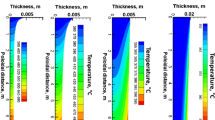Abstract
Liquid metal plasma facing components are considered an attractive design choice for fusion devices including pilot plants. Virtual prototyping of such devices includes modeling of free-surface flow of the electrically conductive liquid, which requires computational fluid dynamics (CFD) and magnetohydrodynamics (MHD) simulations. Numerical tools capable of simulating flows and heat transfer in the free-surface MHD flow were developed at PPPL based on the customized ANSYS CFX. MHD is introduced using a magnetic vector potential approach. Free-surface flow capabilities are available in the code and were tested. Special stabilization procedures were derived and applied to improve convergence of the momentum equations with the source terms due to the Lorentz force and surface tension. Important characteristics of the fusion-relevant liquid metal flow is free surface smoothness and stability. Heat flux from the plasma impacts the liquid surface at a very acute angle, so any change of the free surface from axisymmetry can dramatically increase the local heat flux density and thus create excessive evaporation of liquid lithium into the plasma, which is detrimental to operations. Stability analysis of the liquid metal film flow was performed to determine applicable flow regimes. Thin film flow along horizontal wall is considered. Effects of gravity, magnetic field, and surface tension are included in the analysis.





Similar content being viewed by others
References
F. Yang, A. Khodak, H.A. Stone, Nuclear Mater. Energy 18, 175–181 (2019)
H. Davison, Compilation of thermophysical properties of liquid lithium, NASA TN D-4650, (1968)
J. Brackbill et al., J. Comput. Phys. 100, 335–354 (1992)
ANSYS CFX-Solver Theory Guide, Release 17 ANSYS Inc. (2016)
A. Khodak, C. Kessel, M. Tillack, Fusion Sci. Technol. 75(8), 930–938 (2019)
A. Khodak et al., Fusion Eng. Des. 137, 124–129 (2018)
A. Khodak, IEEE Trans. Plasma Sci. 45(9), 2561–2565 (2017)
S. Smolentsev et al., Fusion Eng. Des. 100, 6572 (2015)
Chandrasekhar, Hydrodynamic and Hydromagnetic Stability. Oxford, Clarendon (1961).
M.A. Jaworski et al., Nucl. Fusion 53, 083032 (2013)
L.D. Landau, E.M. Lifshitz, Fluid Mechanics. Pergamon Press, Oxford (1959).
G. Miloshevsky, A. Hassanein, Nucl. Fusion 50, 115005 (2010)
Acknowledgements
This manuscript is based upon work supported by the U.S. Department of Energy, Office of Science, Office of Fusion Energy Sciences, and has been authored by Princeton University under Contract Number DE-AC02-09CH11466 with the U.S. Department of Energy.
Author information
Authors and Affiliations
Corresponding author
Additional information
Publisher's Note
Springer Nature remains neutral with regard to jurisdictional claims in published maps and institutional affiliations.
Rights and permissions
About this article
Cite this article
Khodak, A., Yang, F. & Stone, H.A. Free-Surface Liquid Lithium Flow Modeling and Stability Analysis for Fusion Applications. J Fusion Energ 39, 455–461 (2020). https://doi.org/10.1007/s10894-020-00261-6
Accepted:
Published:
Issue Date:
DOI: https://doi.org/10.1007/s10894-020-00261-6



